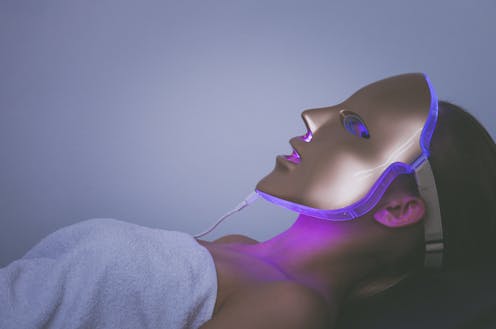LED face masks are popular on social media for glowing skin – but they could disrupt your sleep
- Written by Dean J. Miller, Research Officer, CQUniversity Australia

LED face masks are the latest device promoted on social media as a marriage of technology and beauty.
A range of celebrities have endorsed portable versions of the product that was previously offered in beauty salons. Actress Olivia Munn carries hers with her at all times. Julia Roberts, Victoria Beckham and Chrissy Tiegen are also reportedly fans. The trend has even achieved the social media holy grail – a Kardashian Instagram post.
But regardless of whether they’ll help make your skin glow, our understanding of circadian rhythms suggests they have the potential to disrupt users’ sleep-wake cycles.
Read more: 6 ways to stop daylight saving derailing your child’s sleep
Daily rhythms
The human body has its own internal clock which, among other things, helps to control our sleep-wake patterns. This internal clock is influenced by several factors, the most potent being light exposure directly into the eyes. More specifically, short-wavelength “blue light” influences this system the most.
Exposure to this type of light at night has been shown interrupt the production of melatonin – also known as “the sleep hormone”. Melatonin is produced by the pineal gland in the brain and released within 2 hours of your habitual bedtime – preparing the body for sleep. But bright blue light exposure may interrupt this process.
There are a range of sources for blue light – including our beloved phones, electronic devices and also the room lighting in our homes. While it has become a common recommendation to avoid using electronic devices close to bedtime, in the context of blue light exposure, our phones and tablets do not seem to be bright enough to impact sleep. In fact, home lighting appears to have a greater influence – likely due to the transition to energy-efficient LED, “blue light” wavelength light.
Last year, Monash University researchers examined sleep and light exposure in 57 participants, finding that nearly half of them had LED lighting that suppressed melatonin by 50%. The study also found those with greater evening light exposure had increased wakefulness after bedtime.
Insufficient sleep has been shown to increase the likelihood of poor health outcomes, including cardiovascular disease.
Read more: Poor sleep is really bad for your health. But we found exercise can offset some of these harms
How face masks compare to other LED sources
LED mask manufacturers say they are the “future of skin care”, with masks emitting light at different wavelengths to target particular skin-related outcomes.
Several devices are FDA-approved in the United States, and claim to target acne with “blue light” modes – the precise wavelength range that may impact melatonin production.
To date, no experimental research studies have examined the impact of these devices, and their blue light settings, on sleep or the human body clock. But given the device’s proximity to users’ eyes and the intensity of LED light bulbs, it is reasonable to flag concerns about their possible impact on our body clock.
Sean Cain, a leading scientist on the impact of light exposure on human health, coined an analogy to provide perspective to the sources of artificial light. The light we receive from electronic devices can be thought of as like a glass of water being poured over your head, while home LED lighting is more like a bucket of water. In keeping with this analogy, could LED masks be something on the scale of a bathtub or swimming pool? Further research could quantify their effect.
Read more: Snooze blues? How using your favourite song as an alarm can help you wake up more alert
You can still make like a Kardashian … in the daytime
These concerns, based on well-established circadian principles, do not rule out the use of these devices entirely. However, it is important for people who use them to avoid doing so at night – especially on the blue light settings.
Ideally, use of the masks should be during daylight hours, to avoid potential sleep disturbances and/or shifts in the human body clock. Future research could clarify any negative outcomes associated with these devices and potentially prompt manufacturers to provide recommendations on the timing of their use.
Authors: Dean J. Miller, Research Officer, CQUniversity Australia



